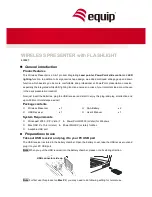
E
34
Re
feren
ce
S
ect
io
n
The Shooting Menu (
A
(Auto) Mode)
Image Mode (Image Size and Quality)
See “Changing the Image Size (Image Mode)” (
61) for more information on
Image mode
.
White Balance (Adjusting Hue)
The color of light reflected from an object varies with the color of the light source.
The human brain is able to adapt to changes in the color of the light source, with
the result that white objects appear white whether seen in the shade, direct
sunlight, or under incandescent lighting. Digital cameras can mimic this
adjustment of the human eye by processing images according to the color of the
light source. This is known as “white balance.” For natural colors, select a white
balance setting that matches the light source before shooting.
Although the default setting,
Auto
, can be used under most types of lighting, you
can apply the white balance setting suited to a particular light source to achieve
more accurate results.
The icon for the current setting other than
Auto
is displayed on the monitor
6).
B
Notes on White Balance
•
At white-balance settings other than
Auto
or
Flash
, set the flash mode to
W
(off) (
•
This feature may not be used in combination with certain features. See “Features That Cannot Be
Used Simultaneously” (
63) for more information.
Display the shooting screen in
A
(Auto) mode (
M
d
button
M
A
tab (
11)
M
White balance
Option
Description
a
Auto
(default setting)
White balance is automatically adjusted to suit lighting
conditions. Best choice in most situations.
b
Preset manual
Useful when shooting under unusual lighting. See “Using Preset
Manual” for more information (
c
Daylight
White balance adjusted for direct sunlight.
d
Incandescent
Use under incandescent lighting.
e
Fluorescent
Use under fluorescent lighting.
f
Cloudy
Use when taking pictures under overcast skies.
g
Flash
Use with the flash.
Summary of Contents for COOLPIX AW100
Page 1: ...En Reference Manual DIGITAL CAMERA ...
Page 60: ...36 ...
Page 92: ...68 ...
Page 116: ...92 ...
Page 214: ...E94 ...
















































